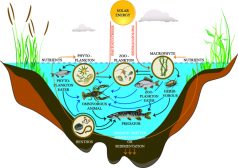Definition
noun, plural: adipocytes
A specialized connective tissue cell that stores fat (lipid); the predominant cell in the adipose tissues
Supplement
In animals, the connective tissue is one of the major types of tissues and its main functions are to provide structural support and to connect tissues and organs. The cellular elements of the connective tissues are adipocytes, fibroblasts, and blood cells (such as macrophages, mast cells, etc.).
The adipocytes are specialized type of connective tissue cells in the adipose tissue. They comprise the bulk of the adipose tissues. Other cells (collectively called stromal vascular fraction) are present in relatively fewer number. In general, the adipocytes are bloated with globules of triglycerides. The nucleus is displaced to one side and the cytoplasm is seen as a thin line around the fat droplet.
The main function of adipocytes is to store fat. Apart from serving as a source of energy in the form of fat, the adipose tissue is also important in providing cushion, thermal insulation of vital organs, lubrication (chiefly in the pericardium), and hormones (such as leptin). There are two major types of adipose tissues: (1) white adipose tissue and (2) brown adipose tissue.
The white adipose tissue is comprised of white fat cells. These adipoctytes are monovacuolar. The cell has a large lipid droplet in its cytoplasm and a flattened nucleus at the periphery. The fat molecules contained in these adipocytes are primarily triglycerides and cholesteryl ester.
The brown adipose tissue has a darker colour. Its main function is to generate body heat. The brown fat cells are plurivacuolar. The adipocyte in this tissue contains several smaller droplets, with round nucleus that is eccentrically located, and more mitochondria (which accounts for the brownish color). The brown adipose tissue has more capillaries than white adipose tissue has.
Synonym(s):
- fat cell
- lipocyte
See also:







